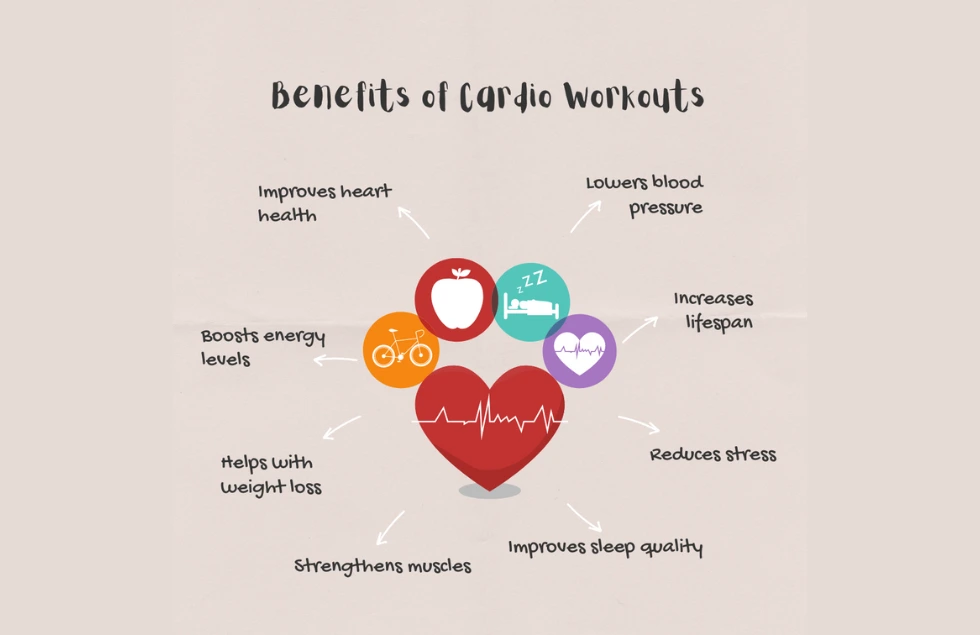Have you ever experienced that worn-out feeling after sitting at your desk for hours, even though you haven’t physically exerted yourself? Or perhaps you have found yourself gasping for breath after walking up a flight of stairs. This is common for most people. It is a consequence of a sedentary lifestyle. This modern epidemic is affecting millions of people worldwide.
A study published in the International Journal of Behavioral Nutrition and Physical Activity found that higher amounts of sedentary behavior increase the risk for all-cause mortality, cardiovascular disease, and cancer.
Fortunately, there’s a simple yet powerful solution – regular cardio workouts. By incorporating cardio exercise into your routine, you can combat the negative effects of a sedentary lifestyle and improve your overall health and well-being. In this blog, we will share the many benefits of cardio and discover how it can transform your life. But first, let’s talk about cardio and how it differs from other forms of exercise.
What is Cardio?
Cardiovascular exercise, often referred to as cardio, is a type of physical activity that elevates your heart rate and works your cardiovascular system. The cardiovascular system delivers oxygen and nutrients throughout your body while also removing waste products.
 Source: Freepik
Source: Freepik
The primary goal of cardio is to increase your heart rate above its resting level. This elevated heart rate forces your heart and lungs to work harder, leading to improved cardiovascular efficiency. Over time, this increased efficiency can result in a stronger heart, lower resting heart rate, and better endurance.
Types of Cardio
There are numerous types of cardio workouts you can incorporate into your fitness routine. Each type offers unique benefits and can cater to different preferences and fitness goals. Some popular types of cardio include:
|
Workout Type |
Description |
Benefits |
| Step Workouts | Using a raised platform to perform rhythmic movements. | Improves coordination, balance, and lower body strength. |
| Treadmill | Simulates walking, jogging, or running with various incline options and resistance levels. | Versatile, suits different fitness levels, improves cardiovascular health. |
| Elliptical Trainer | Low-impact machine providing a full-body workout. | Targets legs, core, and upper body; low impact on joints. |
| Stationary Bike | Cardio machine for indoor cycling and spin classes with various resistance levels. | Targets legs and core; low impact, suitable for all fitness levels. |
| Rowing Machine | Full-body cardio machine for indoor and outdoor rowing. | Engages legs, core, upper body, and back; low impact. |
| High-Intensity Interval Training (HIIT) | Alternating short bursts of intense exercise with rest periods. | Improves cardiovascular fitness, burns calories, increases strength. |
| Running and Jogging | Classic cardio activities for a full-body workout, done outdoors or on a treadmill. | Engages legs, core, and upper body; improves cardiovascular health. |
| Cycling | Low-impact exercise for indoor or outdoor cycling. | Targets legs and core; gentle on joints, suitable for all fitness levels. |
| Swimming | Full-body workout in a pool, lake, or ocean. | Engages all major muscle groups; low impact, suitable for all ages and fitness levels. |
| Dancing | Rhythmic movements in various dance styles like Zumba, hip-hop, salsa, and ballroom. | Fun, engages various muscle groups, improves coordination and cardiovascular health. |
| Aerobic Classes | Structured cardio workouts incorporating movements like jumping jacks, high knees, and burpees. | Motivating, improves cardiovascular health, and overall fitness. |
| Rowing | Full-body cardio exercise for indoor or outdoor rowing. | Engages legs, core, upper body, and back; low impact. |
| Hiking | Walking uphill on various trails, from easy nature walks to challenging mountain climbs. | Combines cardio with outdoor activities, improves cardiovascular health, and leg strength. |
Benefits of Cardio Workouts
Scientific studies have consistently shown the positive impact of cardio exercise on health. For instance, a study published by the American Heart Association found that individuals who engage in regular aerobic exercise have a significantly lower risk of cardiovascular diseases. Another research study highlighted that 150 minutes of moderate-intensity cardio exercise per week can lead to substantial health benefits, including improved heart health and reduced mortality rates.
Let’s discuss these benefits in detail.
Physical Health Benefits
- Cardiovascular Health: Regular cardio exercise is a cornerstone of cardiovascular health. It strengthens your heart, improves blood circulation, and lowers blood pressure. This reduces your risk of heart disease, stroke, and other cardiovascular conditions.
- Weight Management: Cardio workouts are excellent for burning calories and aiding in weight loss or maintenance. The more you engage in cardio, the more calories you’ll burn, helping you achieve your weight goals.
- Muscle Strength and Endurance: While cardio is primarily known for improving cardiovascular fitness, it also plays a role in building muscle strength and endurance. By challenging your muscles during cardio activities, you can enhance your overall physical performance.
- Improved Bone Density: As you age, your bones naturally lose density, increasing the risk of fractures. Cardio exercises, especially weight-bearing activities like running and dancing, can help maintain strong bones and reduce the risk of osteoporosis.
 Source: stay healh stay fit
Source: stay healh stay fit
Mental Health Benefits
- Stress Reduction: Cardio workouts are a natural stress reliever. They release endorphins, the body’s feel-good hormones, which can help reduce stress, anxiety, and improve mood.
- Improved Mood: Engaging in regular cardio can have a positive impact on your mental well-being. It can boost your energy levels, combat fatigue, and alleviate symptoms of depression.
- Better Sleep: A good night’s sleep is essential for overall health. Cardio exercise can help improve sleep quality by promoting relaxation and reducing stress.
- Enhanced Cognitive Function: Studies have shown that regular cardio exercise can improve cognitive function, including memory, attention, and problem-solving skills.
| Benefit | Journal/Study Name | Research Findings |
| Cardiovascular Health | European Heart Journal | Regular aerobic exercise significantly lowers the risk of cardiovascular diseases. |
| American Heart Association | Recommends at least 150 minutes of moderate-intensity aerobic activity per week for heart health. | |
| Weight Management | Centers for Disease Control and Prevention (CDC) | Consistent aerobic activity helps manage body weight and reduce the risk of obesity. |
| Muscle Strength and Endurance | BMC Public Health | Regular physical activity, including cardio, enhances muscle function and endurance. |
| Improved Bone Density | National Institutes of Health (NIH) | Regular physical activity, including aerobic exercises, is beneficial for bone health and prevents bone density loss. |
| Metabolic Health | Harvard-affiliated Massachusetts General Hospital | 12 minutes of vigorous exercise can positively impact more than 80% of circulating metabolites. |
| Cellular and Molecular Benefits | Broad Institute of MIT and Harvard | Physical activity causes beneficial changes in all 19 organs studied, aiding in treatment development. |
Quick Tips for Effective Cardio Workouts
The key to sticking to a cardio routine is to find activities that you genuinely enjoy. Whether it’s dancing, swimming, cycling, or hiking, choose something that excites you and makes you look forward to your workouts.
Watch this video to learn more about how to incorporate cardio into your routine and discover new ways to stay active and healthy. Remember, consistency is key in reaping the full benefits of cardiovascular exercise.
-
Start Slow and Steady: Begin with manageable goals and gradually increase the intensity and duration of your workouts.
-
Warm-Up and Cool-Down: Prepare your body for exercise with a brief warm-up and aid muscle recovery with a cool-down.
-
Listen to Your Body: Avoid overexertion and pay attention to any discomfort or pain. Rest when needed.
-
Stay Hydrated: Drink plenty of water to prevent dehydration and maintain optimal performance.
-
Track Your Progress: Use a fitness tracker to monitor your progress, stay motivated, and set new goals.
Fuel Your Fitness Journey with Cardio
By incorporating cardio exercise into your daily routine, you can combat the negative effects of a sedentary lifestyle, improve your cardiovascular health, manage weight, enhance muscle strength and endurance, and boost your mental well-being.
For more such fitness tips and advice, check out Stay Fit Stay Healthy for expert guidance and inspiration on achieving your fitness goals. Remember, consistency is key when it comes to maintaining a healthy lifestyle, so stay committed and keep pushing yourself to reach new heights of fitness and well-being.

